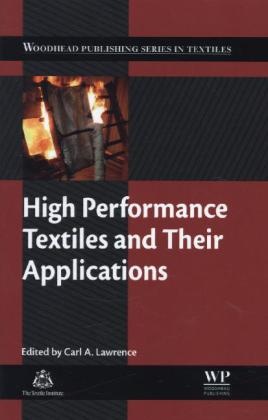Read more
High performance textiles represent one of the most dynamic sectors of the international textile and clothing industry. With contributions from leading experts in the field, this book provides an important overview of key developments in the field. Chapters cover the use of high performance textiles in such areas as protective clothing, heat and fire protection, medicine, civil engineering and the energy sector.
List of contents
- Contributor contact details
- Woodhead Publishing Series in Textiles
- 1. Modelling structure-property relationships in advanced textile materials
- Abstract:
- 1.1 Introduction to textile modelling
- 1.2 Approaches to modelling geometry, structure, properties and processes
- 1.3 Experimental models
- 1.4 Modelling the geometry of fibre, yarn and fabric
- 1.5 Modelling the structure of textiles
- 1.6 Modelling the mechanical properties of textiles
- 1.7 Modelling the physical properties of textiles
- 1.8 Modelling textile processes: continuous models
- 1.9 Modelling textile processes: discrete models
- 1.10 Optimization of performance characteristics: linear and non-linear methods
- 1.11 Sources of further information and advice
- 1.12 References
- 2. Novel surface treatments for high performance textiles
- Abstract:
- 2.1 Introduction
- 2.2 Plasma technologies for textiles
- 2.3 Plasma treatments for high performance textiles
- 2.4 Laser technologies for textiles
- 2.5 Comparing plasma and laser treatments of textile surfaces
- 2.6 Conclusions
- 2.7 References
- 3. High performance textiles for protective clothing
- Abstract:
- 3.1 Introduction
- 3.2 Requirements for protective clothing
- 3.3 High performance textile fibres
- 3.4 Conventional and high performance fibre blends for protective clothing
- 3.5 Cut resistant and energy absorption materials
- 3.6 Clothing for firefighters
- 3.7 Chemical protective clothing (CPC)
- 3.8 Materials to improve thermo-physiological comfort of protective clothing
- 3.9 References
- 4. High performance textiles for heat and fire protection
- Abstract:
- 4.1 Introduction
- 4.2 Principles of textile heat and fire protection
- 4.3 Routes to achieving fire and heat protection
- 4.4 Evolving technologies and future trends for heat and fire protection
- 4.5 Applications of heat protective textiles
- 4.6 Sources of further information and advice
- 4.7 References
- 5. High performance medical textiles: an overview
- Abstract:
- 5.1 Introduction
- 5.2 Textiles for hygiene and infection control
- 5.3 High performance implantable textiles
- 5.4 Textiles for tissue engineering applications
- 5.5 Textiles for healthcare monitoring
- 5.6 Future trends
- 5.7 References
- 6. High performance textiles for wound care
- Abstract:
- 6.1 Introduction
- 6.2 Wounds and wound management
- 6.3 Wound dressings
- 6.4 Hi-tech wound dressings: non-adherent, odour adsorbent, activated charcoal cloth (ACC), and antimicrobial dressings
- 6.5 Treatment of venous leg ulcers
- 6.6 Venous leg ulcer treatment using compression bandages
- 6.7 Improving compression bandages: non-woven vari-stretch compression bandages (NVCB) and three-dimensional compression bandages
- 6.8 Conclusions
- 6.9 References
- 7. High performance textiles for industrial filtration
- Abstract:
- 7.1 Introduction
- 7.2 Dust collection
- 7.3 Fibre selection for dust collection
- 7.4 Fabric types for dust collection
- 7.5 Fabric finishing techniques
- 7.6 Solid-liquid filtration
- 7.7 Filtration equipment
- 7.8 Fabric selection for solid-liquid filtration
- 7.9 Fabric constructions and yarn types for solid-liquid filtration
- 7.10 Fabric finishing techniques
- 7.11 Future trends
- 7.12 Sources of further information and advice
- 7.13 References
- 8. High performance textiles for geotechnical engineering: geotextiles and relate
About the author
Carl Lawrence, formerly University of Leeds, UK
Summary
High performance textiles represent one of the most dynamic sectors of the international textile and clothing industry. With contributions from leading experts in the field, this book provides an important overview of key developments in the field.
Report
"...brings together contributions from an international team of authors from both academia and industry. It will be an essential reference work for textile technologists, scientists and researchers." --Asian Technical Textiles, 2014

